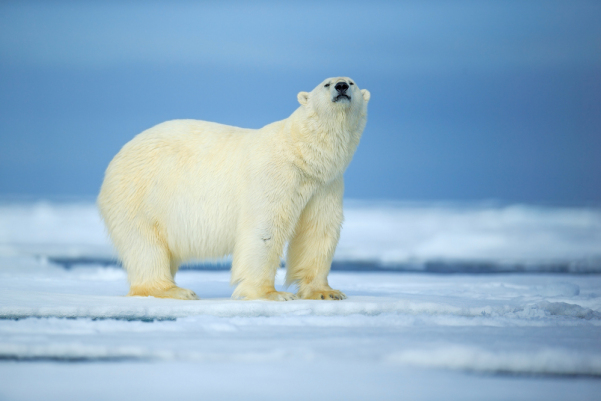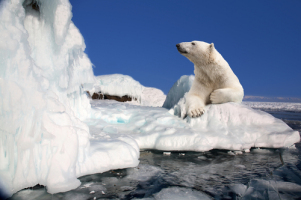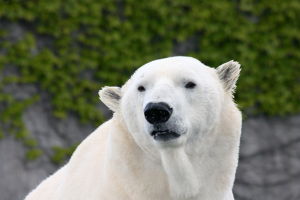
The Polar Bear(Ursus maritimus) is an iconic symbol of the north. These awesome mammals Reach weights up to 800 kilograms, making it one of the largest terrestrial carnivores on earth. Seals are one of its primary food sources. Polar Bears are known to cover large distances in search of food, they may swim for several kilometers, or wander far inland which sometimes causes conflicts with humans. Polar Bear range lies largely within the Arctic Circle, encompassing the Arctic Ocean,
Physical Characteristics
Polar Bears have proportionately longer necks than other species of bear, this makes it easier for them to lunge after seals and other prey. The sole of a Polar Bear’s foot has thick, black pads covered with small, soft papillae (dermal bumps). The papillae create friction between the foot and ice to prevent slipping. Long hairs growing between pads and toes also help prevent slipping. The front paws are round and partially webbed. The back paws are elongated. Each toe has a thick, curved, non-retractile claw. The claws are used for holding prey and for traction when maneuvering on ice. The skin is black, this enables the bear to absorb sunlight energy to warm its body.
| Length | 2-3.3 m(6’7″-10’10”) |
| Shoulder Height | 1.2-1.6 m(3’11”-5’3″) |
| Tail Length | 7-13 cm(3″-5″) |
| Weight | 150-800 kg(331-1,764 lbs.) |

Habitat and Distribution
The Polar Bear’s range spans the far northern reaches of Alaska, Canada, Russia, Greenland, and Norway. The habitat includes arctic sea ice, water, islands, and continental coastlines. The global Polar Bear population is estimated at 20,000 to 25,000 individuals.
Breeding
Polar Bears breed in the spring. Pregnant females make dens near shore, and after a gestation period of about 8 months the mother gives birth to 1 to 4 cubs. A cub may weigh less than 1 kilogram at birth. The cubs begin walking while in the den at about two months old. By the time they are able to go outside they can weigh up to 15 kilograms. The cubs can often be killed by males so the mother is very defensive of them when males are nearby. The cubs stay with their mothers for about thirty months.
Diet
Polar Bears are an apex predator that eats pinnipeds such as Ringed Seals, Bearded Seals, Harp Seals, Hooded Seals, and Walruses. Polar Bears also eat Belugas, Reindeer, fish, small rodents, seabirds, waterfowl, eggs, vegetation, berries, human garbage, and will also occasionally scavenge on carcasses.

Fun Facts
- “The Woman who Raised a Bear as her Son” was an animated program released in 1990 by Lacewood Productions, Hinton Animation Studios, CTV Television Network, and Telefilm Canada. This cartoon was based on an Inuit folktale of an old woman and the orphaned Polar Bear cub she took in as her own child.
- The Canadian two-dollar coin has an image of a Polar Bear on its reverse side, while a special millennium edition featured three.
- International Polar Bear Day is a yearly event celebrated every February 27, to coincide with the time period when Polar Bear moms and cubs are sleeping in their dens, and to raise awareness about the conservation status of the Polar Bear.
- The Polar Bear is embroidered on the Coat of Arms of Chukotka Autonomous Okrug in the Russian Federation, and also is on the Coat of Arms of the Greenlandic Self-Rule government (Kalaallit Nunaat).
- The Polar Bear was the official mascot of the 1988 Winter Olympics held in Calgary, Alberta, Canada.
- Nelvana Enterprises, Inc. is a Canadian animation studio and entertainment company owned by Corus Entertainment that uses an illustration of a Polar Bear on their logo.
- The Eisbaren Berlin hockey team uses a Polar Bear as their logo, and the Charlotte, North Carolina hockey team the Charlotte Checkers uses a Polar Bear named Chubby Checker as their mascot.
- The Klondike Bar is an ice cream product that is manufactured by Good Humor-Breyers that has a Polar Bear illustrated on its packaging.
- Vehicle license plates in the Northwest Territories in Canada are in the shape of a Polar Bear, as was the case in Nunavut until 2012; these now display Polar Bear artwork instead.
- The Polar Bear is the mascot of Bowdoin College, Maine; and the University of Alaska Fairbanks.
- A long muzzle and neck help Polar Bears look into deep holes for seals.
